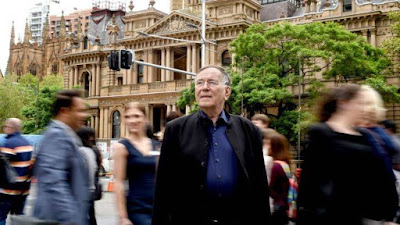Jan Gehl: Key to the City
By Julia Moiso
 |
| Jan Gehl Source: Steven Siewert |
Jan
Gehl (80) is a Danish architect and urban designer who founded Gehl Architects – Urban Quality Consultants,
based in Copenhagen, Denmark. His work and research creatively reimagines the
multiple ways in which communities utilise the city and the public realm. For Gehl,
design always begins with an analysis of the spaces between buildings. Only
after establishing a vision of what kind of public life is desired in a city
of public space, attention can then be given to the surrounding buildings
and the ways the spaces can productively interact. He is a man on a mission to
transform Sydney into a walking and cycling-friendly destination, has been
proudly been awarded by Lord Mayor Clover Moore, the key to the City of Sydney.
He is also the second Dane to receive a Key to the City of Sydney, following Jørn Utzon who received the honour in 1998, famously known for being the Architect behind Sydney’s legendary Opera House.
While first being commissioned by the City of Sydney in
2007, more than a decade onwards, Jan Gehl has contributed driving ideas behind
Sydney’s recent transformation including plans to ‘pedestrianise’ George Street, bring inner-city laneways to
life, and create a greener, more liveable and better connected city as part of
the Sustainable Sydney 2030 initiative.
Presenting a
symbolic key to the city is the highest honour a city can give to an individual
or organisation. It recognises the recipient’s contribution to furthering the
ideals of a city or an outstanding achievement at an international level. Previous
individuals awarded the Key to the City of Sydney have been received by Nelson
Mandela (1990), Dame Joan Sutherland (1991), Juan Antonio Samaranch (2000),
Aung San Suu Kyi (2003), John Bell AO (2015), and various Australian Olympic,
Paralympic and other sporting teams and personalities.
Gehl comments
about his role in the city’s planning; he observed that Sydney had, for too
long, put cars ahead of people. This is a trait many cities often slip into
subconsciously, rather than planning for people, infrastructure is often
prioritised to continuously plan for upgraded road networks, a seemingly never
ending investment - currently exhibited by the NSW State Government. Gehl
believes that the most successful places have in fact, outgrown the automobile.
This can be seen all around the world in Copenhagen, Denmark; Halifax, Canada;
Melbourne, Australia; and Times Square, New York to name a few cities who have
ditched the roads for pedestrian friendly environments.
Together, Gehl
Architects and the City of Sydney Council under Lord Mayor Clover Moore
developed a plan to unlock Sydney’s outstanding potential by making it a city
for people, with walkable streets, great public spaces and a vibrant, green
heart. Lord Mayor Clover Moore has commended Gehl’s work since being
commissioned a decade ago and has made extensive efforts to implement his
recommendations. From simple initiatives to make the streets more liveable like
upgrading functional street furniture, planting more trees and incorporating
more greenery into the city, to major projects like the transformation of
George Street, the light rail and the improvement of laneway life throughout
the city centre.
The City
continues to embrace Gehl’s vision for Sydney with continual improvements to
ensure a better quality public realm is accomplished and a more sustainable
future for the city is achieved for future generations.
We believe that
Gehl’s work in rejuvenating the city will help create a more liveable city with
a primary people centric vision. Despite the continual rise in private
vehicular travel seen globally, can it be said that this approach will help
revolutionise cities? Is this approach seen as a global trend for a successful
city? Is this seen as an ecologically, economically and socially just and fair
strategy to the contribution of revitalisation to the city?


Comments
Post a Comment